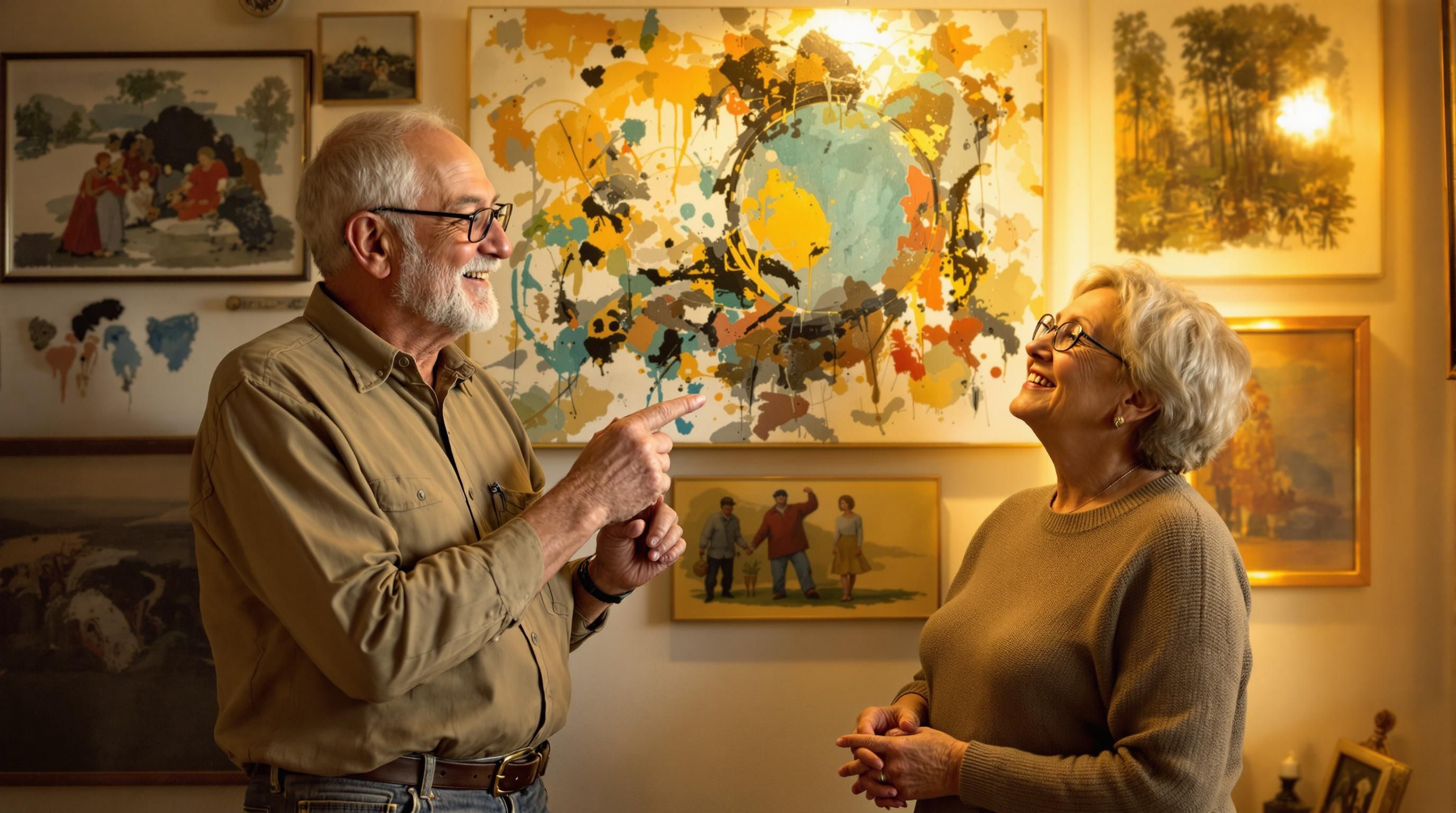Introduction: The Extraordinary Vogel Collection

What makes the Vogel collection truly extraordinary isn’t just its immense financial value—which has been estimated in the hundreds of millions of dollars—but the story of how it was built: through passion, knowledge, personal relationships with artists, and a commitment to collecting art not as an investment but as a way of life.
This article explores the monetary and cultural value of the Herb and Dorothy Vogel collection, its origins, its current status, and why it represents one of the most significant private art collections ever assembled in the United States.
The Vogels: America's Most Unlikely Art Collectors
The Vogel Collection Timeline
- 1960s
Collection Beginnings
After marrying in 1962, the Vogels began collecting art using Herb's postal clerk salary while living on Dorothy's librarian income. - 1970s-80s
Collection Growth
The Vogels focused on minimal and conceptual art, developing relationships with emerging artists like Sol LeWitt, Donald Judd, and Richard Tuttle. - 1992
National Gallery Agreement
The Vogels agreed to transfer their entire collection to the National Gallery of Art in Washington, D.C. - 2008
50x50 Project Launch
The "Fifty Works for Fifty States" initiative distributed 2,500 works from the collection to museums across all 50 states. - 2012
Herbert Vogel's Passing
Herbert Vogel passed away at age 89, leaving behind an extraordinary artistic legacy.
What made the Vogels’ approach to collecting unique was their self-imposed restrictions and methodology:
- They only purchased artwork they could carry home on public transportation or in a taxi
- Every piece had to fit in their small apartment
- They lived on Dorothy’s salary and used Herb’s income exclusively for purchasing art
- They bought works directly from artists, often before they became famous
- They prioritized personal relationships with artists over market considerations
This approach allowed them to amass over 4,782 works of art, primarily drawings, but also including paintings, sculptures, and other media—all while living in their modest one-bedroom apartment on New York’s Upper East Side.
The Vogel Collection By The Numbers
Valuing the Invaluable: The Financial Worth of the Collection
When considering the value of the Vogel collection, several factors come into play:
Artist Prominence and Market Performance
The Vogels collected works from artists who would go on to become major figures in contemporary art. Artists in their collection include:
Selected Artists in the Vogel Collection and Current Market Values
Representative auction prices for works similar to those in the Vogel collection
</tbody>
</table>
Historical Significance and Provenance
The Vogel provenance (record of ownership) adds significant value to each work in the collection. Their remarkable story and curatorial vision enhance the historical importance of each piece they collected.
The “En Bloc” Value
Art collections sometimes have greater value when kept together rather than sold piece by piece, as they represent a cohesive curatorial vision. The Vogel collection, spanning decades of American minimal and conceptual art, has immense historical significance as a singular entity.
Comparative Collections
Comparable collections of minimal and conceptual art have sold or been valued in the hundreds of millions. For example, the collection of donors like the late Robert Scull, which featured similar artists and periods, has seen individual works sell for tens of millions.
According to Forbes and other publications, by the time of Herbert Vogel’s death in 2012, the collection was “worth incalculable amounts: hundreds of millions of dollars, and climbing.” This valuation continues to grow as the market for minimal and conceptual art strengthens.
The 50x50 Project: Distributing the Collection

However, the collection had grown so large that the National Gallery could not possibly display or store it all. This led to the creation of the “Fifty Works for Fifty States” initiative in 2008, through which 2,500 works from the collection were distributed to museums in all 50 states.
The 50x50 project ensured that:
- Each state received 50 representative works from the collection
- The works would remain accessible to the public rather than disappearing into private hands
- The Vogels’ legacy would touch communities across the entire United States
- Smaller museums would have access to significant contemporary art
This democratic approach to art distribution reflected the Vogels’ own democratic approach to collecting. Rather than selling their collection for personal profit or donating it exclusively to major institutions in art capitals, they ensured that Americans throughout the country would have access to important contemporary art.
Museums Housing Vogel Collection Works
National Gallery of Art
The primary repository of the Vogel Collection, holding the core works donated by Herbert and Dorothy Vogel.
50x50: The Herbert and Dorothy Vogel Collection
Official website of the 50x50 project, with details about the distribution of works to museums in all 50 states.
Buffalo AKG Art Museum
New York state's recipient of 50 works from the Vogel Collection through the 50x50 project.
Colorado Springs Fine Arts Center
Colorado's recipient institution displaying works from the Vogel Collection.
Lessons for Today's Collectors: The Vogel Approach

The Vogel Collection Principles
Key strategies used by the Vogels that today's collectors can learn from:
- Focus on artwork they genuinely loved rather than what might appreciate in value
- Developed deep knowledge of specific art movements (minimal and conceptual art)
- Built personal relationships with artists, collecting their work consistently over time
- Set clear parameters for their collection (size restrictions, budget limits)
- Prioritized works on paper, which were more affordable than large sculptures or paintings
- Purchased art directly from artists early in their careers
- Viewed collecting as a passion and lifestyle, not purely as an investment
While the specific economic conditions that enabled the Vogels’ collection have changed significantly since the 1960s and 1970s, many of their principles remain applicable. Today’s aspiring collectors might consider:
- Focus on emerging artists: Research and support artists early in their careers when work is more affordable
- Set a consistent budget: Allocate a specific portion of income exclusively for art purchases
- Develop expertise: Build knowledge in specific niches or movements rather than collecting broadly
- Attend studio visits and art schools: Connect directly with artists before they sign with major galleries
- Consider less expensive media: Focus on drawings, prints, photographs, or digital art rather than large paintings or sculptures
While today’s art market differs dramatically from the 1960s when the Vogels began collecting, their story demonstrates that passionate collecting remains possible for those willing to develop expertise, focus on relationships with artists, and prioritize love of art over financial speculation.
Dorothy Vogel Today: Continuing the Legacy
Dorothy Vogel remains actively involved in:
- Documentary film projects: Both “Herb & Dorothy” (2008) and its sequel “Herb & Dorothy 50x50” (2013) document the Vogels’ remarkable story
- Educational outreach: Speaking engagements and programs about art collecting
- Museum collaborations: Working with institutions that house pieces from their collection
- Archival preservation: Organizing documentation related to their collection and correspondence with artists
Though their apartment is no longer packed floor-to-ceiling with artwork, Dorothy continues to champion the importance of public access to art and the value of collecting based on passion rather than investment potential.
Notable Sales of Works by Artists in the Vogel Collection
Recent auction results for artists heavily represented in the Vogel Collection
| Category | Price | Notes |
|---|---|---|
| Sol LeWitt | $50,000 - $500,000+ | For drawings and wall pieces |
| Richard Tuttle | $30,000 - $250,000 | For small mixed media works |
| Christo and Jeanne-Claude | $15,000 - $200,000 | For preparatory drawings |
| Pat Steir | $20,000 - $450,000 | For paintings and works on paper |
| Donald Judd | $100,000 - $10,000,000+ | For sculptures and wall pieces |
</tbody>
</table>
Determining the Value of Your Own Art Collection
Art Collection Valuation Factors
Key considerations when determining the value of artworks:
- Artist reputation and career stage
- Provenance (ownership history) and exhibition history
- Condition of the artwork
- Size, medium, and subject matter
- Rarity and significance within the artist's body of work
- Recent comparable sales at auction or galleries
- Current market trends for similar works
For collectors looking to assess the value of their collections, several approaches are available:
- Professional appraisals: Work with certified art appraisers, particularly for insurance or donation purposes
- Auction estimates: Auction houses can provide preliminary valuations for potential consignments
- Online valuation tools: Platforms like Artsy and Artnet offer market data for comparable works
- Gallery consultations: Galleries that represent your artists may provide informal valuations
- Collection management software: Tools that track purchases and current market data for similar works
Remember that art valuation is not an exact science and can fluctuate based on market conditions, artist career developments, and broader economic factors.
Resources for Art Collection Valuation
American Society of Appraisers
Professional organization for certified appraisers who specialize in art and collectibles valuation.
Artsy Price Database
Subscription database of auction results to help determine current market values for specific artists.
Art Collection Value Tracker - MoMAA
Tool for organizing and monitoring your art collection's value over time based on current market data.
ArtNet Price Database
Comprehensive database of auction results spanning decades of art market activity.
How to tell if your art is valuable
Guidance on identifying potentially valuable artworks in your collection.
The Cultural Impact and Legacy of the Vogel Collection
The collection’s legacy includes:
- Democratizing art collecting: The Vogels demonstrated that art collecting wasn’t exclusive to the wealthy
- Documentation of artistic movements: The collection provides a comprehensive record of minimal and conceptual art development
- Alternative collecting model: Their approach offered a counterpoint to market-driven collecting strategies
- Public accessibility: Through donation to public institutions, they ensured widespread access to significant art
- Educational impact: Their story continues to inspire new generations of collectors and art enthusiasts
The 50x50 project in particular has had a profound impact on smaller museums across the United States, bringing important contemporary art to communities that might otherwise have limited access to works of this caliber.
Common Questions About the Herb and Dorothy Vogel Collection
How much was the Herb and Dorothy Vogel art collection worth?
While never officially appraised in its entirety (as it was donated rather than sold), the Vogel collection has been estimated to be worth hundreds of millions of dollars. According to Forbes and other publications, by the time of Herbert Vogel's death in 2012, the collection was "worth incalculable amounts: hundreds of millions of dollars, and climbing." Individual works by artists they collected, such as Donald Judd and Sol LeWitt, now sell for millions at auction.
Is Dorothy Vogel still alive today?
Yes, as of 2024, Dorothy Vogel is still alive. After Herbert Vogel's death in 2012, Dorothy has continued to be involved in art world activities and has worked to preserve the couple's legacy through documentary films and educational initiatives.
What happened to the Herb and Dorothy Vogel art collection?
In 1992, the Vogels decided to transfer their entire collection to the National Gallery of Art in Washington, D.C. because it charges no admission, does not sell donated works, and they wanted their art to belong to the public. Since the collection had grown too large for any single institution, in 2008 they launched the "Fifty Works for Fifty States" initiative, which distributed 2,500 works to museums across all 50 states, with 50 works going to a selected museum in each state.
Could someone today do what the Vogels did in the 1950s and 60s?
The specific economic conditions that enabled the Vogels' collection have changed significantly. Art prices have increased dramatically, and the accessibility to emerging artists has become more competitive. However, many of their principles remain applicable for today's collectors on a budget: focus on emerging artists, build relationships directly with artists, develop expertise in specific niches, consider more affordable media like drawings and prints, and collect consistently over time with a dedicated budget.
How many children did Herb and Dorothy Vogel have?
Herb and Dorothy Vogel did not have any children. They often referred to their art collection as their "children" and devoted their lives to collecting and caring for their artwork.
How do I find out how much my art collection is worth?
To determine the value of your art collection, you can: 1) Hire a professional art appraiser certified by organizations like the American Society of Appraisers, 2) Consult with auction houses for preliminary valuations, 3) Use online databases like Artsy or Artnet to research comparable sales, 4) Work with galleries that represent your artists, or 5) Use collection management software that tracks market data. For insurance or tax purposes, professional appraisals are typically required.
Where can I watch the Herb and Dorothy documentary?
The documentary films "Herb & Dorothy" (2008) and its sequel "Herb & Dorothy 50x50" (2013) are available on various streaming platforms including Amazon Prime Video, Apple TV, and PBS. You may also find them through educational streaming services at libraries and universities. The original documentary won the Audience Award at the Silverdocs Film Festival and offers an intimate look at the Vogels' collecting journey.
What types of art did the Vogels primarily collect?
The Vogels primarily collected minimal and conceptual art. Their collection focused heavily on works on paper (drawings), though it also included paintings, sculptures, and mixed media pieces. They collected works from artists including Sol LeWitt, Donald Judd, Richard Tuttle, Pat Steir, Christo and Jeanne-Claude, Chuck Close, and many others who were part of the minimal and conceptual art movements of the 1960s, 70s, and 80s.
Conclusion: The Priceless Value of Passion-Driven Collecting
Their legacy demonstrates that:
- Knowledge and relationships can be more valuable than deep pockets when building a collection
- Patient, consistent collecting over decades can result in extraordinary outcomes
- Collections built on genuine passion often have greater coherence and historical significance
- The most meaningful impact of collecting may come from sharing art with the public
The Vogels, who could have sold their collection for immense profit, chose instead to ensure public access to the art they loved—a decision that cemented their legacy not just as collectors but as cultural philanthropists of the highest order.
For those interested in building their own collections, the Vogel story offers both inspiration and practical guidance: focus on what you love, learn everything you can about it, connect directly with artists, collect consistently within your means, and consider how your collection might ultimately benefit others.
In an art world increasingly dominated by investment-driven purchasing and speculation, the Vogel collection stands as a powerful reminder that the most meaningful and ultimately valuable collections grow from genuine passion, deep knowledge, and personal connection to the art and artists themselves.
External Resources
Herb & Dorothy Documentary
Award-winning documentary about the Vogels and their remarkable art collection, available through PBS Independent Lens.
The Vogel 50x50 Collection
Official site of the initiative that distributed the Vogel collection to museums in all 50 states.
National Gallery of Art: Vogel Collection
The National Gallery's presentation of works from the Vogel Collection, including exhibition information.
Mental Floss: How a Working-Class Couple Amassed a Priceless Art Collection
In-depth article on the Vogels' collecting journey and the significance of their collection.
Buffalo AKG Art Museum Vogel Collection
Example of a recipient institution from the 50x50 project, featuring works from the Vogel Collection.
Forbes: Great American Art Collector Herbert Vogel Dies
Forbes article discussing Herbert Vogel's legacy and the value of their collection upon his death in 2012.
VICE: Why This Couple Gave Away Their Priceless Art Collection
VICE article exploring the Vogels' decision to donate their entire collection rather than sell it.
Art Collection Value Tracker
Tool for collectors to track and estimate the value of their own art collections over time.
Get a Professional Appraisal
Unsure about your item’s value? Our certified experts provide fast, written appraisals you can trust.
- Expert report with photos and comps
- Fast turnaround
- Fixed, upfront pricing
No obligation. Secure upload.
| Item | Price | Date | Auction House |
|---|---|---|---|
| Sol LeWitt Wall Drawing #1114 | $1,130,000 | June 2021 | Christie's |
| Donald Judd Untitled (Stack) | $9,835,000 | November 2022 | Sotheby's |
| Richard Serra Equal VIII | $1,815,000 | May 2023 | Phillips |
| Pat Steir Year of the Mushroom | $855,000 | March 2023 | Christie's |



